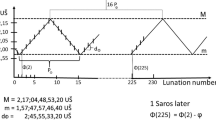Abstract
This paper is the second part of an investigation into Babylonian non-mathematical astronomical texts and the relationships between Babylonian observational and predicted astronomical data. Part I (Gray and Steele 2008) showed that the predictions found in the Almanacs and Normal Star Almanacs were almost certainly made by applying Goal-Year periods to observations recorded in the Goal-Year Texts. The paper showed that the differences in dates of records between the Goal-Year Texts and the Almanacs or Normal Star Almanacs were consistent with the date corrections of a few days which, according to theoretical calculations, should be added to allow for the inexactness of Goal-Year periods. The current paper follows on from our earlier study to consider the effect of the Babylonian calendar on Goal-Year methods of prediction. Due to the fact that the Babylonian calendar year can contain either 12 or 13 months, a Goal-Year period can occasionally be month longer or shorter than usual. This suggests that there should in theory be certain points in the Metonic intercalation cycle where a predicted event occurs one Babylonian month earlier or later than the corresponding event a Goal-Year period later. By comparing dates of lunar and planetary records in the Astronomical Diaries, Goal-Year Texts, Almanacs and Normal Star Almanacs, we show that these month differences between the observational records and the predictions occur in the expected years. This lends further support to the theory that the Almanacs’ and Normal Star Almanacs’ predictions originated from records in the Goal-Year Texts, and clarifies how the Goal-Year periods were used in practice.
Similar content being viewed by others
References
Brack-Bernsen, L. 1999. Ancient and modern utilization of the lunar data recorded on the Babylonian Goal-Year tablets. In Actes de la V ème Conférence de la SEAC, Warszawa-Gdansk, eds. LeBeuf, A. and Ziólkowski, M.Z., 13–39.
Britton, J.P. 2007. Calendars, intercalations and year-lengths in mesopotamian astronomy. In Calendars and Years: Astronomy and Time in the Ancient Near East (Oxford), ed. Steele, J.M., 115–132.
Epping, J. 1889. Astronomisches aus Babylon (Freiburg).
Gray J.M.K., Steele J.M. (2008) Studies on Babylonian goal-year astronomy I: a comparison between planetary data in Goal-Year Texts, Almanacs and Normal Star Almanacs. Archive for History of Exact Sciences 62: 553–600
Hunger, H. 2006. Astronomical Diaries and Related Texts from Babylonia Volume VI (Vienna).
Kugler, F.X. 1909–1924. Sternkunde und Sterndienst in Babel, Buch II (Münster).
Kugler, F.X. and J. Schaumberger. 1935. Sternkunde und Sterndienst in Babel, 3. Ergänzungscheft zum ersten und zweiten Buch (Münster).
Neugebauger, O. 1955. Astronomical Cuneiform Texts (London).
Roughton, N.A. 2002. A study of Babylonian normal-star almanacs and observational texts. In Under One Sky: Astronomy and Mathematics in the Ancient Near East, eds. J.M. Steele and A. Imhausen (Ugarit-Verlag).
Sachs A.J. (1948) A classification of Babylonian astronomical tablets of the seleucid period. Journal of Cuneiform Studies 2: 271–290
Sachs, A.J. 1955. Late Babylonian Astronomical and Related Texts (Providence).
Sachs A.J. (1976) The Last Datable Cuneiform Tablets. Alter Orient und Altes Testament 25: 379–398
Sachs, A.J. and H. Hunger. 1988. Astronomical Diaries and Related Texts from Babylonia Volume I (Vienna).
Sachs, A.J. and H. Hunger. 1989. Astronomical Diaries and Related Texts from Babylonia Volume II (Vienna).
Sachs, A.J. and H. Hunger. 1996. Astronomical Diaries and Related Texts from Babylonia Volume III (Vienna).
Sachs A.J., Walker C.B.F. (1984) Kepler’s View of the Star of Bethlehem and the Babylonian Almanac for 7/6 B.C. Iraq 46: 43–56
Steele, J.M.2007. The length of the month in Mesopotamian calendars of the first millennium BC. In Calendars and Years: Astronomy and Time in the Ancient Near East (Oxford), ed. J.M. Steele, 133–148.
Steele, J.M. 2009. Goal-Year periods and their use in predicting planetary phenomena. In Die empirische Dimension altorientalischer Forschungen (Vienna), ed. Selz, G. (in press).
Author information
Authors and Affiliations
Corresponding author
Additional information
Communicated by A. Jones.
Rights and permissions
About this article
Cite this article
Gray, J.M.K., Steele, J.M. Studies on Babylonian goal-year astronomy II: the Babylonian calendar and goal-year methods of prediction. Arch. Hist. Exact Sci. 63, 611–633 (2009). https://doi.org/10.1007/s00407-009-0048-z
Received:
Published:
Issue Date:
DOI: https://doi.org/10.1007/s00407-009-0048-z




